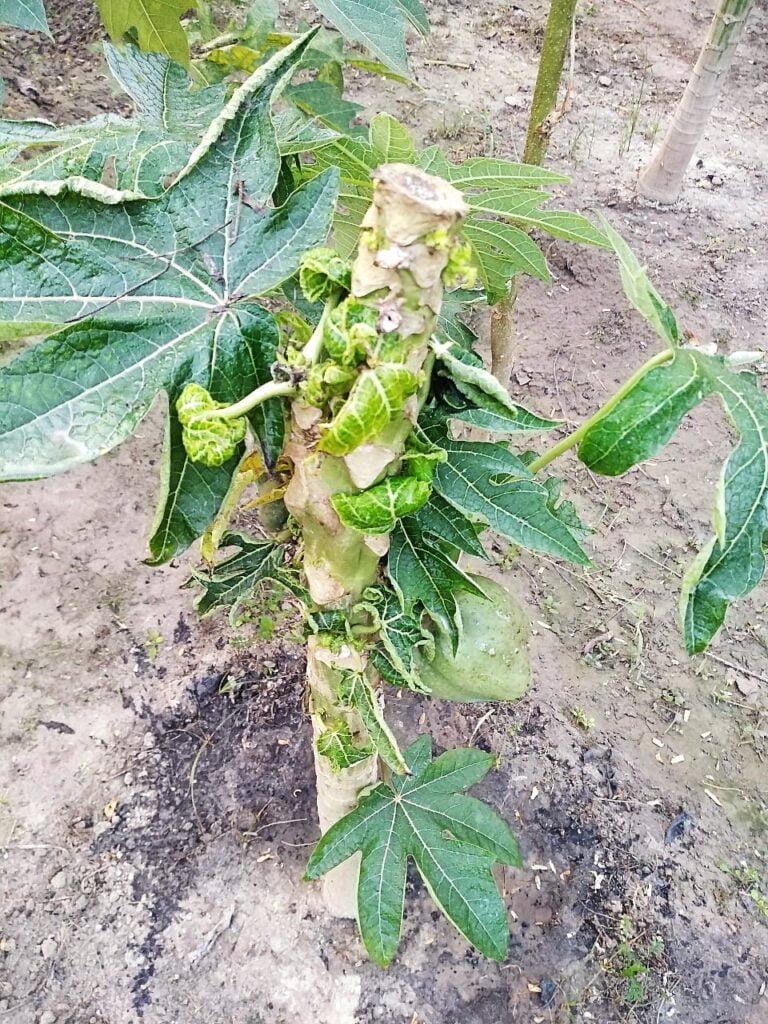Leaf Curl of Papaya
Leaf curl of papaya disease is an extremely dangerous DNA type of bacterial virus disease. Which belongs to the Begomoviral genus and family of Geminiviridae. This virus causes severe damage to papaya plants, which is why it causes huge economic losses. The leaf curl virus is spread with an insect vector belonging to the Aleyrodidae.
This virus can be the main cause of papaya’s curl and many other diseases besides curl. The virus was first seen on papaya plants in India, but now wherever papaya is grown, the virus attacks more. The virus spreads rapidly, which is why it is so difficult to control. Leaf curl of papaya is one of the most dangerous diseases for the orchids.
The curl of Papayas is caused by
Papaya disease (PaLCV) was first ever seen about ninety years ago, in this joint part of India and Pakistan, which is now called India. After that papaya disease was discovered in south Taiwan about 20 years ago. The papaya disease is caused by a special virus known as begomovirus. Sweet potato whiteflies transmit this virus to papaya plants, which causes the spread of curl of disease in papaya and hosts too many diseases.
Symptoms of leaf curl of papaya

Leaves on symptomatic plants were wrinkled and twisted, and they had yellow veins running through them. Petioles were small in stature and displayed a thick, twisted form. There were either no fruits at all on the vines or they were very little and misshapen. We confirmed PaLCuV infection in sick papaya plants by isolating DNA from their leaves and then amplifying the viral gene with PaLCuV gene-specific primers using a polymerase chain reaction.
Isolated DNA samples from diseased plant leaves amplified a 1.6 kb amplicon containing the PaLCuV gene, while DNA samples from healthy plant leaves showed no evidence of gene amplification. This finding proves without a reasonable doubt that plant infections caused by PaLCuV are responsible for the aforementioned symptoms. Leaf curl symptoms of a plant affected by leaf curl disease, leaf curling and downing towards, Petals curling, and increased thickness of veins in the leaves. In infected plants with the condition of leaf curl, Lamina is deficient in the leaves of plants as well as affects the quality of the fruit which falls off prematurely.
Papaya Leaf Curl Disease Treatment
Once the virus invades the papaya orchard, the virus spreads rapidly and is not only difficult to control but also further spreads the disease through insects. The use of pesticides would also be effective in controlling the disease. There are a few methods to control papaya leaf curl disease treatment. Commercial varieties resistant to mosaic are developed to control the disease but have not yet achieved significant success. The use of anti-virus methods has been shown to be beneficial in controlling this.
Papaya Leaf Curl Virus Treatment
Pesticides and crop rotation are the two main methods used to combat the spread of PaLCuV nowadays. When required, we also resort to removing diseased fields and re-routing affected plants. As a result, additional cultural means of controlling vector populations are becoming increasingly important for a comprehensive integrated pest management plan as an alternative to the use of huge quantities of insecticides.
Curl Virus Control
As mentioned above there are no proper methods for papaya leaf curl control but using the following papaya leaf curl control methods can control the leaf curl of papaya disease.
- Proper arrangements are made to clean the papaya garden.
- Weeds are removed from the Papaya orchids
- Since the disease is transmitted by whiteflies, spray appropriately and promptly to eradicate whiteflies from the Papaya garden.
- The use of insect killer traps to control whiteflies and other, insect killer traps is one of the best strategies for controlling the insects for papaya orchids, so hanging insect killer traps in the papaya garden.
- Infected plants should be removed from the papaya garden so that the disease does not spread further.
Leaf Curl of Papaya Biological Control
The biological control of the papaya curl consists of releasing natural predators of the papaya mealybug, Paracoccus marginatus, such as the wasp, Anagyrus lopezi, the parasitic nematode, Steinernema carpocapsae, the predatory mite, Phytoseiulus macropilis, and the predatory bug, Orius insidiosus. These predators feed on the mealybugs, reducing their population and controlling the papaya curl infestation.

